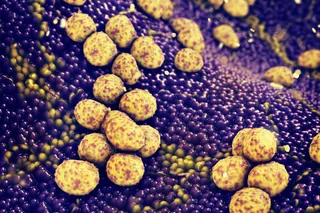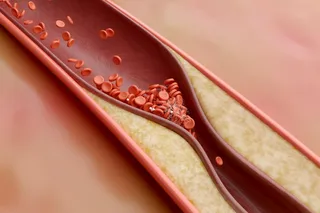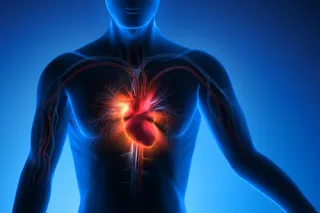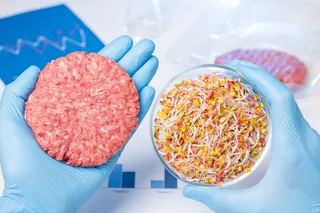Nicolas and Marta Sanchez were worried. For two days, their 10-year-old daughter, Raquel, had been running a fever. Now she complained of irritated eyes, a flushed face, and a cough. Watching her chest rise and fall, her parents counted 22 breaths per minute, a bit faster than normal. This was no ordinary cold.
Raquel's history gave them plenty of reason to worry. She was their miracle child. Ten years earlier, she was born full term with a lusty cry— and with skin and eyes the color of maize. Don't worry, the doctors had said, lots of newborns need a day or two under lights to help clear excess bilirubin— a component of bile— from the blood. Nicolas and Marta had waited patiently. But unlike her nursery-mates, Raquel stayed yellow.
Soon Raquel's doctors squirted dye into her veins in order to scan her liver and gallbladder for signs of disease. Then their looks turned grave. The high level of bilirubin was not caused by broken-down hemoglobin from a mother-infant blood reaction. The accumulation was a result of malformed liver ducts. Biliary atresia, they called it.
A surgeon tried to create an outlet to divert Raquel's bottled-up bile. Still her color didn't change.
Raquel's last hope was a liver transplant. Shortly after her first birthday, surgeons removed Raquel's liver and replaced it with a healthy one. Eventually, a Y-shaped scar and pills to help her body accept the transplant were the only reminders of her rocky start.
Now Raquel was sick again. Nicolas and Marta knew that antirejection drugs keep transplant patients alive because they paralyze the immune system. What might be a minor flu in another child could be a disaster in Raquel.
Jaime de la Torre, a pediatric infectious diseases consultant, met Raquel Sanchez a few hours after her admission to my hospital. By then, her brown eyes were rimmed with red, and fiery blotches covered her face, arms, and trunk. The intern and resident had already jotted down a differential diagnosis— scarlet fever, toxic shock syndrome, Kawasaki disease, adenovirus, enterovirus, drug rash— and put her on intravenous antibiotics.
De la Torre, a native of Peru, took one look and knew better. "Think again," he said. "What contagious rash still kills nearly a million kids every year?"
The answer was on the tip of their tongue, but they hesitated. That possibility was a disease they— and many of their teachers— had only read about in textbooks. And if Raquel Sanchez really had what De la Torre suspected, where on Earth had she picked it up?
The consultant turned to Raquel."OK, cara," he crooned, "open wide. Let's see the inside of your mouth." Sure enough, in the flashlight's glare were lacy blue patches opposite her second molars.
"Koplik's spots straight from the textbook. Isolate now!" he barked. "This kid has measles."
Until an effective measles vaccine was licensed in the United States in 1963, measles was one of childhood's greatest perils. And where vaccination rates remain low, it still is. Measles probably causes 10 percent of deaths worldwide in children under age 5.
Measles begins like many other airborne viral infections. First, tiny spheres containing viral protein and RNA breach respiratory linings anywhere from the nose to the lower airways. Then they sweep through the bloodstream, infecting white blood cells. These cells release new spheres that ricochet back to the eyes, ears, nose, throat, and lungs, eventually carpeting every square inch of vulnerable respiratory surface. Now the victim has fever, a hacking cough, and watery eyes. Within hours Koplik's spots— the infection of cells in the mouth— appear, followed by measles' classic rash.
Along with these symptoms come more ominous effects. First, tissues damaged by the measles virus are vulnerable to bacterial infections. That's why pneumonia is the last straw for many measles-infected infants.
But the effects of the virus extend far beyond the lungs. Because the rubeola virus invades a special class of virus-fighting immune cells, called T lymphocytes, it can depress the entire immune system for weeks. Intestinal infection causes the gut lining to slough, tipping many toddlers into malnutrition. And in youngsters whose diets lack enough vitamin A, the shortage of nutrients can swiftly lead to blindness. In rare cases, the infection progresses to the brain, causing neurological damage or death.
Raquel was lucky. She had an ordinary case of measles. Yes, her chest X ray showed a patch of pneumonia in her left lung. But once the antibiotics started to work, her breathing calmed and her cough settled down.
Meanwhile, De la Torre had two more questions for Raquel's parents. Had she ever received a measles shot? And where might she have caught measles? He knew that measles cases in Los Angeles were at an all-time low.
Offhand, Nicolas and Marta didn't remember specific vaccines and years. But Nicolas did recall a recent outing, "S’, two weekends ago, we were in Tijuana. We shopped, ate, listened to mariachis. But we saw no one with spots."
Like most people, Nicolas didn't know that measles is most infectious a day or two before the rash. And because of measles' contagiousness, a single cough or sneeze aimed at Raquel from another viral victim was all that was needed to launch a new infection. The interval from exposure to illness also fit perfectly: 10 to 14 days.
The next day, the final piece of the puzzle fell into place. Raquel's parents brought in her immunization card, and her doctor confirmed that she had never received a measles-mumps-rubella vaccine. Now De la Torre believed he could reconstruct the entire sequence of events.
Not all childhood vaccines are alike. Some shots, such as tetanus, polio, whooping cough, and hepatitis B, are made from killed microbes or their components. However, two vaccines— measles-mumps-rubella and chicken pox— contain live, weakened organisms. In healthy kids, these crippled viruses do no harm, but in transplant patients whose immune systems are held in check by drugs, there's a chance organisms can proliferate out of control.
In the first year and a half of Raquel Sanchez's life, her doctors were simply trying to keep her alive, and the measles vaccination most likely just slipped through the cracks. Her liver transplant kept her alive, but she, like all transplant patients, was now especially vulnerable to infection. What doctor would willfully expose her to an infectious risk, even a weakened vaccine virus? And so her opportunity to be immunized against measles was lost forever.
Of course, there is another scenario. Before her transplant, maybe Raquel's doctors figured that measles had already been conquered at home and that was enough. In other words, she really didn't need the vaccine. If so, they were naive. Today's transplant patients aren't bubble kids. They eat international foods, cross borders, and share air and germs with the rest of the global villagers. Ironically, in doing so, they are sometimes the first to expose chinks in our public health armor.
Before you hop that next flight or plan an exotic getaway, are you sure that you or your children aren't sitting prey for measles?














